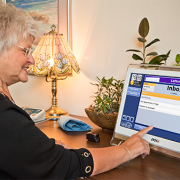Top 3 Ways Seniors Can Keep Busy and Stay Connected While Self-Quarantining
There is no definite timeframe as to when the COVID-19 virus will have subsided and when it will be safe to spend significant amounts of time out in public again. Because people want to preserve their health and avoid public places as much as possible, people are choosing to continue to quarantine for the foreseeable future, especially the elderly.
The COVID-19 virus is unlike anything the world has ever seen, and because of that, people don’t know what to expect when it comes to what’s next in regards to this infectious illness. As people are taking the necessary precautions, specifically seniors, they are growing bored of sitting at home and doing the same thing they have been doing since March. In fact, an expert from a company that handles in-home senior care said that seniors are also beginning to feel isolated while self-quarantining. This post will detail the top 3 ways that seniors can stay connected while also staying entertained while in quarantine.
Ways for Seniors to Entertain Themselves at Home
Seniors are at the most risk of the COVID-19 virus so it’s important that they do all that they can to preserve their health, even if that means quarantining a little bit longer than the rest of the world. If you are a senior and are choosing to preserve your health by staying at home, here are three ways that you can keep your mind occupied while still staying connected to the outside world.
Utilize Video Chatting
Video Chatting is perhaps the best and easiest way for seniors to stay connected to friends and family while in quarantine. Video chatting can be done on a computer, phone, or tablet, making it easily accessible for seniors. Some ways that seniors can call friends and family include:
- Skype
- Facebook Messenger
- Facetime
- Zoom
- Google Hangouts
- A video chatting device designed for seniors, like GrandCare Systems
If you are a senior, you should schedule times with different loved ones as this will give you something to look forward to. Video chatting will also be beneficial to your life even after you no longer have to quarantine as it is a way to catch up with friends and family that don’t live close by.
Join a Virtual Book Club
Building off of the idea of video chatting, consider joining or starting a virtual book club. Virtual book clubs are exactly what they sound like, book clubs that meet online via a video chat. There are countless online book clubs that you can join, or you can start your own informal one. Consider calling friends and family, especially those that are also continuing to self-quarantine, and ask them if they are interested in reading the same book and meet once or a few times a week to discuss it.
Virtual book clubs will give you something to look forward to every few days and will give you the incentive to read- a great way to keep your mind occupied while stuck at home. Choose a book based on your personal interests so that you look forward to reading it.
Play Online Games
Many seniors never consider playing online games as a way to stay connected and occupied. However, online games are an outstanding pastime for aging adults who are trying to limit their public presence as much as possible. Seniors can play games on Facebook, on the internet, on apps, and even on various gaming systems such as PlayStation and Xbox. Some online games (or online versions of games) that are popular amongst the older generation include:
- Words with Friends
- Animal Crossing
- Scrabble
- Minecraft
- Family Feud
- League of Legends
Online games will keep seniors entertained since there are thousands to choose from, and they can also play against or on teams with friends and family. Seniors that are choosing to quarantine and are considering playing online games should consider playing with grandchildren. This will give them the opportunity to be able to bond with their grandchildren in a unique way and stay busy while doing so.
Staying Healthy While Also Staying Connected
It’s important to keep the mind occupied while quarantining, especially for seniors since they will likely have to quarantine for longer than the younger generation who is not at as much of a risk of COVID-19. Keeping the mind occupied will not only have a great impact on one’s happiness, but it could also positively impact a person’s overall mental health. If you are a senior, keep these suggestions in mind as you consider other ways to entertain yourself. Or, if you are not a senior but have a senior in your life, suggest these activities to him or her and try to be a part of them.
About the Author
Kelsey Simpson enjoys writing about things that can help others. She lives in South Jersey and is the proud companion to two German Shepherds and spends her free time volunteering in dog shelters.
















